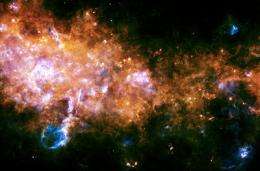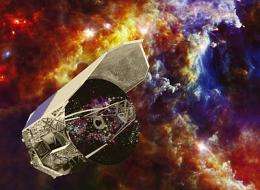Explorer of the 'Cool Universe'

(PhysOrg.com) -- Emory astrochemist Susanna Widicus Weaver will soon begin one of the first broad spectral surveys of small organic molecules in deep space. Her lab's research proposal - to search for the raw materials of life in star-forming regions - recently won 42 hours of observing time on the Herschel Space Observatory.
“The process for applying is incredibly competitive, and 42 hours is a huge amount of time, so we’re ecstatic,” Weaver said. “I actually watched the Herschel instrument evolve over the past 10 years, so I have to pinch myself that this is actually happening.”
Astrochemistry draws on astronomy, laboratory spectroscopy and chemical modeling to study chemical mechanisms in space. Weaver is skilled in all three of these specialized areas.
As a graduate student at Caltech, she would visit the NASA Jet Propulsion Laboratory and marvel at the technology going into building the Herschel instruments. Headed by the European Space Agency, Herschel became the largest telescope in space when it launched last year. The scope’s 3.5 meter-diameter mirror offers an unprecedented view of the “cool universe,” the domain of objects like tiny stars and molecular clouds that barely emit light. It may not seem as glamorous as looking for new planets, but scientists believe that the cool universe holds secrets for how life forms. Herschel operates in the far-infrared range, penetrating the veil of gas and dust shrouding these cooler realms by bridging the gap between infrared and radio astronomy.
Weaver’s research is focused on that gap, in the terahertz frequency range. At Emory, she is developing the technology to search for the building blocks of life in this largely unexplored area of deep space. Students are helping her build a high-sensitivity spectrometer to record the terahertz transmission frequency of transient molecules that are key building blocks to forming simple molecules of sugars and amino acids.

Weaver theorizes that these transient molecules are present in deep space. On Earth, however, they are unstable, existing only for the blink of an eye. So Weaver is developing methods to make the molecules and keep them stable in a laboratory environment. Using spectroscopy to record the spectral “fingerprints” of the molecules gives the lab a guide to search for them in space.
Weaver and her students are frequent visitors to the Caltech Submillimeter Observatory on the Mauna Kea volcano of the Big Island of Hawaii, where they acquire terahertz spectra with a 10.4-meter radio astronomy dish. This dish is a powerful device, situated in a high, dry and dark location, but observations are still hampered by the Earth’s atmosphere, which blocks most far-infrared wavelengths, while also producing its own far-infrared radiation. Observing terahertz radiation from the ground is like trying to see stars on a cloudy night.
“That’s the reason that the Herschel telescope is so incredible. This is the first time we can observe molecules in the terahertz range from space,” Weaver says.
Weaver and her students will use their time on the Herschel observatory to search for a range of simple molecules that they have identified as key to prebiotic pathways in interstellar chemistry, such as acetic acid, methyl formate, glycolaldehyde and methanol.
“Most previous observations have targeted a few specific molecules, but we want to open that up and get a better idea of the average composition of the clouds in star-forming regions,” Weaver explains.
Provided by Emory University

















